CBE Starter Pack 1: Students are Empowered Daily
CompetencyWorks Blog
When educators begin to explore competency-based education (CBE), the CompetencyWorks Initiative is a key place to find information and ideas. It can be overwhelming to know where to start. This post is the first of a series of “CBE Starter Packs.” Each post focuses on one of the seven elements of the Aurora Institute’s 2019 CBE Definition. You’ll find information on why it is important for learning and how it supports equity. You’ll find example policies and practices to look for and a curated sampling of resources to get started.
CBE Definition Element 1: Students are empowered daily to make important decisions about their learning experiences, how they will create and apply knowledge, and how they will demonstrate their learning.
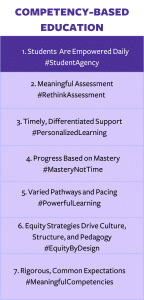 As students develop agency, they find purpose in learning, persist through challenges, and manage their own learning. Competency-based schools design environments and experiences that give students opportunities to develop the skills and mindsets needed for a strong sense of agency, such as growth mindset, self-regulation, and perseverance.
As students develop agency, they find purpose in learning, persist through challenges, and manage their own learning. Competency-based schools design environments and experiences that give students opportunities to develop the skills and mindsets needed for a strong sense of agency, such as growth mindset, self-regulation, and perseverance.
The learning sciences emphasize that learning is something done by students, not to or for students. In order to learn and develop the skills for lifelong learning, students must be supported in their development as independent learners. One of the most transformative changes in personalized, competency-based education is the shift from expecting students to be compliant, passive learners to engaging them as productive, active learners.
As students become active learners with increasing ability to guide their learning, roles and power dynamics in the classroom change. Students have greater ability to make decisions, act on what is important to them, and begin to build intrinsic motivation. Teachers are better able to provide tailored and targeted instruction.
With guidance from educators, students can co-design their learning so that it is relevant to their lives. By extension, personalized and competency-based learning environments help prepare students to take more active roles in effecting change in their own lives and in their own communities beyond their classroom experiences. Cultivating student agency aims to promote equity by developing students’ ability to engage with and identify opportunities to learn and demonstrate their learning in ways that are both effective and meaningful to them. In turn, students develop into adults who have the capacity and resources to direct the course of their own lives, taking action in the world in ways aligned with their values, histories, and goals.
What does it look like when “students are empowered daily”?
Example: Building 21
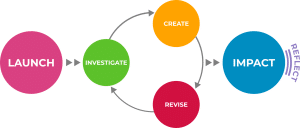
At Building 21, students have access to their personalized learning plan which shows their real-time progress and growth in each of their competency portfolios as well as their progress towards graduation. In some schools, students even choose their target graduation date. They choose “Studios,” 6-12 week learning opportunities organized around a theme—such as neighborhoods, food systems, or global advocacy—that help them learn and demonstrate target competencies. Studio themes are intentionally relevant to students and have space for students to exercise agency in the lines of inquiry they choose and in how they demonstrate their learning. Students can also create additional tasks within the studios and submit evidence based on the competencies they need to complete their portfolios.
Learn more: CompetencyWorks Blog Post: Building 21’s Studio Model: Designing Learning Experiences for Engagement and Impact; Building21 Resource Library; Webinar featuring Building 21
Example: Lindsay Unified
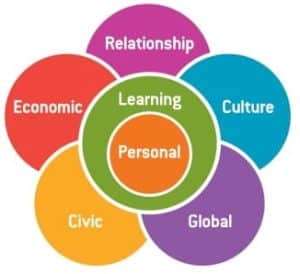
Lindsay Unified School District is “committed to empowering and motivating for today and tomorrow.” Lifelong Learning Standards identify what learners need to know, understand, and be like in order to thrive in an ever-changing world (see the spheres of learning in the image and the full standards on p. 13-20). Students work within a learner-centered Performance-Based System where they play a part in personalizing their learning to meet their academic needs, learning styles, and interests. In the day to day rhythm of learning, outcomes are clearly defined, with empowered students working alongside empowered teachers to figure out how students will learn and demonstrate their learning. In their senior year, students develop a culminating project that they bring to a community panel to discuss what it means to be a culturally aware person or a responsible global citizen.
Learn more: CompetencyWorks Blog Post: Preparing Students for Life….Not Just College and Careers; LUSD YouTube Channel; Education Reimagined Profile of LUSD; Instructional Look Fors Guide
Student Experience “Look Fors”
Can you see these student experience “look fors” in the examples above?
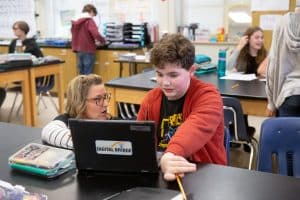
- Students feel seen, welcome, and safe in schools, allowing them to act on opportunities for self-directed decision-making.
- Students have access to culturally responsive curriculum, flexible pathways, and multiple opportunities to learn and demonstrate learning.
- Students have timely access to information about learning targets, definitions of mastery, and their own progress to make decisions about their learning.
- Students can explain what they are working on, why it is important, what they need to do to demonstrate learning, and what they can do if they are struggling.
What school policies and practices support student empowerment?
- Students have opportunities to develop the mindsets, motivations, and skills that promote agency. These competencies are part of their core learning experiences, coaching and advisory, and in extended learning opportunities.
- Designing common assessments and common outcomes enables students to have access to flexible pathways, to co-design projects that reflect their interests, and to have multiple ways to learn and to demonstrate learning.
- Students, regardless of academic achievement levels, are encouraged to take on leadership roles and participate in governance.
- Student-led conferences, exhibitions, and presentations of learning are used to engage parents and guardians in which students prepare and present their growth academically and as learners.
- School strategies to nurture student agency are intentionally monitored to ensure that all students, especially students of color and/or low-income students who have been historically excluded, are receiving the feedback and coaching they need to build skills.
Learn More
Dig into the research and background information
- Toshalis and Nakkula synthesize the research on Motivation, Engagement, and Student Voice. Learners will be more motivated when they value the task. When students feel confident in their ability to accomplish a goal, they are more likely to be successful. Supports need to be available to ensure each student can realize success.
- In What Do You Mean When You Say “Student Agency?”, Jenny Poon synthesizes a definition for student agency with four interrelated elements: setting advantageous goals, initiating action toward those goals, reflecting on and regulating progress toward those goals, and self-efficacy.

- In Maximizing Student Agency: Implementing and Measuring Student-Centered Learning Practices, the American Institutes for Research (AIR) worked with four New Tech Network (NTN) high schools in three states to determine which teacher practices help or hinder the development of student agency, and whether these practices are effective across educational contexts and with different student subgroups. Appendix A (p. 30-33) has menus of teacher and student practices.
Explore Examples and Resources
- The BEST Self-Direction Toolkit is a collection of resources for teachers to use in the classroom for instruction and assessment that focuses on self-direction. The toolkit includes the self-direction rubric, self-direction activities and targeted resources for teachers. All tools are designed by teachers and tested in the classroom.
- In Scaffolds for Student Agency, Tommy Wolfe provides resources from the author’s own adoption of practical scaffolds in the way he uses unit guides, performance task guides, exemplars, and skill cards. Learn how he supports the development of student agency and his own competency-based teaching practices in his high-school science classroom.
- Pathways, Pacing, and Agency Are Intertwined at the Whittier Community School in the Chugach School District in Alaska. This post explores how individual learning plans provide opportunities for different pathways, varied pacing, and student agency.
- This 10-minute Ignite video from #AuroraSymposium2021 explores How Schools Can Help Cultivate Learner Identity and Agency.
- Aligning Systems Change in Three Urban Districts – Rethinking the District Role in Leading for Student Agency is a session from #AuroraSymposium2021. Learn how Dallas Independent School District, Austin Independent School District, and Tulsa Public Schools each developed a unique vision and approach for student ownership and agency as part of a shift in formative assessment practices. Explore how they engaged student voice, model classrooms, district coaches, leadership, and district policy to introduce and spread dramatic shifts in student and teacher roles.
- The CBE Design Principle 1 Rubric is a resource from the book, Unpacking the Competency-Based Classroom, in which Vander Els and Stack offer a roadmap for transforming schools in pursuit of greater equity through competency-based learning.
Supporting Design and Equity Principles
The information above is synthesized from key Aurora and CompetencyWorks publications. In particular, Designing for Equity: Leveraging Competency-Based Education to Ensure All Students Succeed and Quality Principles for Competency-Based Education.
Key Principles for Students are Empowered Daily:
- Equity Principle (p. 32): Support Students in Building Skills for Agency
- Quality Principle #6 (p. 54): Base School Design & Pedagogy on Learning Sciences
- Quality Principle #7 (p. 59): Activate Student Agency & Ownership
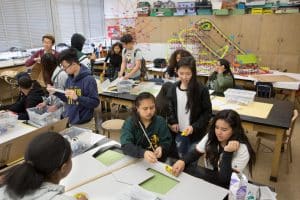
Get Started
Reflecting on your own or with your team, school, district, and/or community is a great way to identify current assets to build on in empowering students and cultivating their agency in learning.
- In what ways do students have opportunities to develop, practice, and apply the mindsets, motivations, and skills they need to develop agency?
- In what way does your district and school demonstrate that student voice and leadership are valued?
- How are teachers supported in building the understanding and competencies to help students build the skills to become lifelong learners?
Once you have an idea of strengths to build on or areas in need of new ideas, what will you do next? Consider actions both in the short term (think: trying one new thing) and in the longer term (think: strategic planning and systems change). Hopefully the resources above give you models, tools, and ideas to adapt to your context or inspire new approaches that work for your community.
Read the Other Posts in the Starter Pack Series
- Implementation with Integrity
- CBE Starter Pack 2: Meaningful Assessment
- CBE Starter Pack 3: Timely, Differentiated Support
- CBE Starter Pack 4: Progress Based on Mastery
- CBE Starter Pack 5: Learn Actively With Varied Pathways and Pacing
- CBE Starter Pack 6: Equity Strategies Drive Culture, Structures, and Pedagogy
- CBE Starter Pack 7: Establish Rigorous, Common Expectations with Meaningful Competencies
Laurie Gagnon is the Aurora Institute’s CompetencyWorks Program Director.